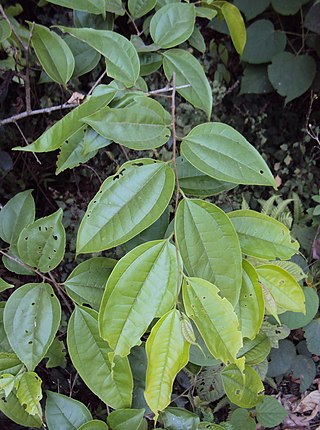
The Javan rusa or Sunda sambar is a large deer species native to Indonesia and East Timor. Introduced populations exist in a wide variety of locations in the Southern Hemisphere.

Varanus timorensis, the Timor monitor or spotted tree monitor, is a species of small monitor lizards native to the island of Timor and some adjacent islands.
The Timor rat is a species of rodent in the family Muridae found in Indonesian West Timor, where it lives in the teak forests. It is known from a specimen collected near the summit of Mount Mutis.

The black-banded flycatcher, also known as the Timor flycatcher, is a species of bird in the family Muscicapidae. In the past the species was considered to be related to the Australasian robins but this was as the result of convergent evolution. It is endemic to Timor island. The black-banded flycatcher is small with a broad bill and distinctive plumage. The species has a white belly, lower rump and throat with a thin black band across the chest. The tail, neck and wings are black and the back, upper wing and shoulders rich chestnut. The plumage of the head is sexually dichromatic, with the head being black in the males and dark grey in the females. The eye and bill is black and the feet and legs are yellow. The calls consist of soft whistles, some of which sound similar to the Timor stubtail.

The spotted shovelnose ray is a species of fish in the Rhinobatidae family. It is endemic to northern Australia. Its natural habitat is open seas.

Moyo is an island in Indonesia's West Nusa Tenggara province. It is off the north coast of Sumbawa Island, and has an area of 349 km2. Moyo Island is located in Sumbawa Regency within the Nusa Tenggara province, just north of Sumbawa. The island has an area of 32,044 hectares, about 8° south of the equator. The island is proposed as part of Moyo Satonda National Park along with Satonda Island.
Hierodula timorensis is a species of praying mantis from the family Mantidae. Found in Timor

Conus timorensis, common name the Timor cone, is a species of sea snail, a marine gastropod mollusk in the family Conidae, the cone snails and their allies.
Neocyprideis timorensis is a species of Indo-Pacific ostracod that has existed since the Miocene.

Celtis timorensis, commonly known as stinkwood or stinking wood, is a species of flowering plant in the family Cannabaceae that grows in tropical Asia. The specific epithet comes from the name of the island of Timor, the locality of the type collection. The most notable characteristic of the tree is the strong excrement odour that it emits from the bark and sap, which pervades the surrounding forest. This is due to the presence of the malodorous organic compound skatole. In Thailand, it therefore known as kæ̂ng k̄hī̂ phrar̀wng or mị̂ chĕd tūd phrar̀wng which means 'wipe the bottom timber'. Thai legend has it that Phra Ruang wiped his buttocks with it. In Sri Lanka the heartwood of the tree is used as a traditional ayurvedic medicine against syphilis, chickenpox, and measles.

Limnonectes timorensis is a species of frogs in the family Dicroglossidae. It is endemic to the island of Timor at the eastern end of the Lesser Sunda Islands. In Timor-Leste it is an infrequent species associated with rivers in tropical montane forests above 1000 m altitude.

Se'i or sei is an Indonesian smoked meat from Kupang, Timor island, East Nusa Tenggara, Indonesia. Se'i may be derived from a variety of meats, with pork, beef or game animals such as venison as common offerings. Today, the most popular se'i meat is pork.
The earthworm snake-eel is an eel in the family Ophichthidae. It was described by Albert Günther in 1870. It is a tropical, marine eel which is known from the Indo-Pacific. It is known to dwell at a depth of 20 metres. Males can reach a maximum total length of 44 centimetres.

Pterolophia is a genus of longhorn beetles of the subfamily Lamiinae, containing the following species:

Borsonia timorensis is a species of sea snail, a marine gastropod mollusc in the family Borsoniidae.
Chiosella is an extinct conodont genus.
Neospathodus is an extinct genus of conodonts.

Delias timorensis is a butterfly in the family Pieridae. It was described by Jean Baptiste Boisduval in 1836. It is found in the Australasian realm.











